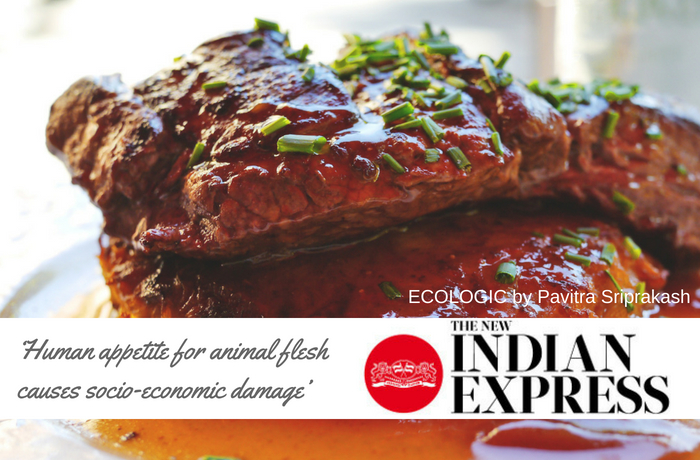14 Jul 18: Pavitra Sriprakash, Director and Chief Designer at Shilpa Architects Planners Designers Pvt. Ltd. writes a weekly column on Sustainability for the New Indian Express. This past Saturdays article address the socio-economic impacts of consuming meat.
Read the Full Article on the New Indian Express site or below:
I was queuing up at a buffet dinner when someone remarked for fun, “I am a strict non–vegetarian.” Eating meat is a private matter, they might say; but it has become apparent that the human appetite for animal flesh is a driving force behind virtually every major category of socio-economic damage threatening everything.
In Central America, 40 percent of all the rainforests have been cleared for cattle pasture to fill bee burgers. Grassland destruction to herd domestic animals have expanded, and environments on which wild animals have thrived are replanted. Pulitzer Prize winner, Risser observed, “Many experience anguish at the wreckage of clear-cut mixed-tree forest, destined to be replaced by a single-species tree farm.”
Fresh water, like land, seemed inexhaustible for the first 10 millennia of civilisation. If we were to break it down, species by species, the heaviest water users will be livestock. A report from the International Water Management Institute, notes that it takes 550 liters of water to produce enough flour for one loaf of bread in developing countries; but up to 7,000 liters of water to produce 100 grams of beef. Giant farms house hundreds of thousands of pigs, chickens, or cows, and produce vast amounts of dung.
These “factory farms” generate more than 130 times the amount of waste that people do. Feeding grain to animals is absurd. A life-cycle analysis of red meat shows that it takes about eight times more energy for a calorie of animal protein than a calorie of protein from grain for human consumption. But livestock also emit global-warming gases directly, as a by-product of digestion. Belching cattle send a significant amount of methane, a potent global-warming gas, into the air.
One ton of methane, the chief agricultural greenhouse gas, has the global warming potential of 23 tons of carbon dioxide. Dairy cows alone account for 16 percent of the world’s annual methane production.
Global travel in ever increasing numbers rapidly transmit viruses across the globe. The problem of containing outbreaks is exacerbated by mass-production of red meat in facilities relying on antibiotics rather than more costly cleaning facilities to fend off infection and disease. NiV or Nipah virus was isolated and identified in 1999 during an outbreak of encephalitis and respiratory illness among pig farmers in Malaysia and Singapore. Its name originated from Sungai Nipah, a village in the Malaysian Peninsula where pig farmers became ill with encephalitis. HIV was caused by illegally eating meat of forest primates. Ebola and SARS are both linked to fruit eating bats whose viruses jumped to humans accidentally.
Albert Einstein, better known for his physics and math than for his interest in the living world, once said: “Nothing will benefit human health and increase chances of survival of life on Earth as much as the evolution to a vegetarian diet.” We don’t think he was just talking about nutrition. Excessive consumption of red meat makes people prone to non-communicable diseases and develop antibiotic resistance.
William Shakespeare’s line from Twelfth Night couldn’t be more apt for my fellow diner: “He is a heavy eater of beef. Me thinks it doth harm to his wit.” Please eat sustainably, and evolve to show kindness to animals and our planet.



